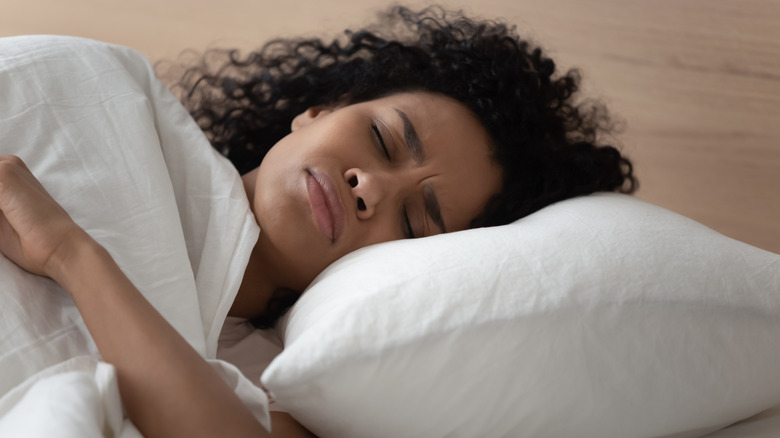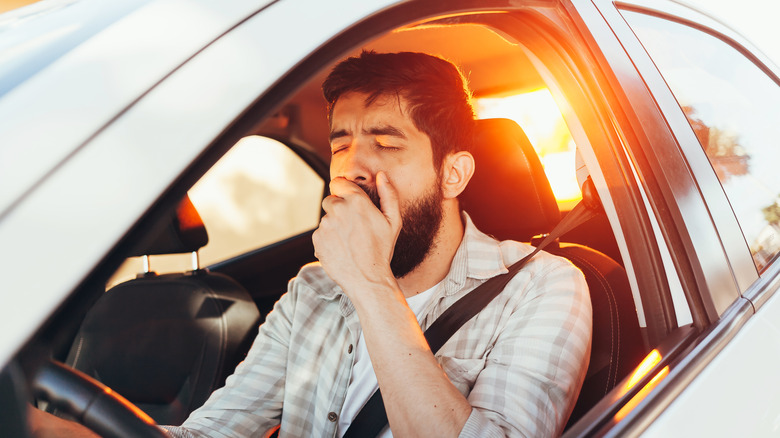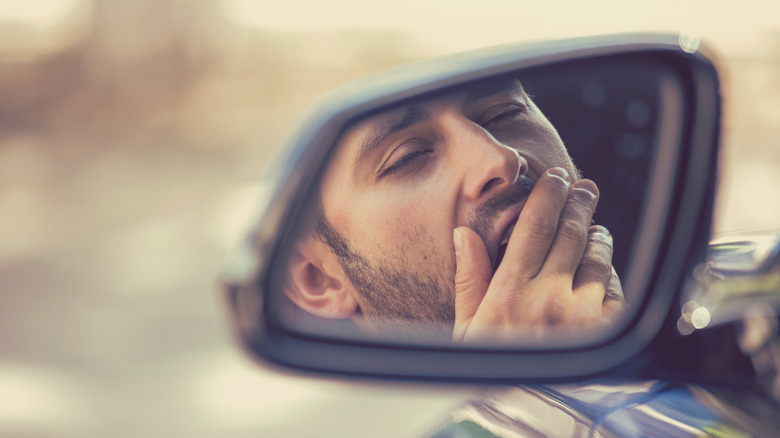Narcolepsy Explained: Causes, Symptoms, And Treatments
Narcolepsy is a chronic neurological condition that affects the brain's ability to regulate the sleep-wake cycle (via CNS Drugs). Marked by overwhelming sleepiness and sudden sleep attacks throughout the day, the condition can heavily affect a person's ability to function. It's usually managed with prescription medication, such as stimulants and antidepressants.
There are two main types of narcolepsy: Type 1, which was once known as "narcolepsy with cataplexy," and type 2, which used to be called "narcolepsy without cataplexy." The condition affects approximately 1 in 2,000 people, but researchers estimate that a large number of individuals live without an official diagnosis for years, per the National Organization for Rare Disorders (NORD).
Although narcolepsy doesn't necessarily harm a person's physical health, it can have disastrous consequences for their safety. For example, an individual could have difficulty staying awake while performing a risky task, such as driving. When they wake up, they may not remember how or when they dozed off or what they were doing when they fell asleep.
Narcolepsy can be managed effectively with the right support. It's important for people to find the right strategies and therapeutic approaches that work for them. Read on to find out more about this relatively rare sleep disorder.
Cataplexy is a common feature of narcolepsy
Cataplexy is often regarded as the hallmark symptom of type 1 narcolepsy (via Cataplexy). While most narcolepsy symptoms crop up in other sleep disorders too, cataplexy is the one symptom that's unique to narcolepsy. Characterized as temporary muscle weakness or loss of muscle control, cataplexy can be tricky to diagnose due to its atypical features (via Nature Reviews Neurology). A person's legs may suddenly collapse, their jaw may drop, or their head may slump to the side. Others may find that their speech becomes slurred or they have difficulty focusing their eyes on things (via Cataplexy).
It's estimated that around 60% of patients with narcolepsy have cataplexy (via CNS Drugs). Approximately 50% of people with the disorder experience both episodes of partial muscle weakness and complete paralysis, whereas 30% experience only partial paralysis of some of their body parts and limbs (via Nature Reviews Neurology).
Cataplexy attacks are usually precipitated by strong positive emotions like elation, surprise, and excited laughter. Sometimes they can be triggered by negative emotions too, such as fear, frustration, or stress. The duration of attacks vary from just a few seconds to several minutes, and in rare cases, it can last for several hours. Some people have cataplexy attacks numerous times a day, whereas others might experience them just once or twice throughout the year. According to anecdotal reports, insufficient sleep and fatigue can exacerbate and increase the frequency of episodes.
Other symptoms to look out for
Like any other illness, narcolepsy symptoms vary across different individuals, reports NORD. Some people experience symptoms on a daily basis, whereas others are affected less frequently. Symptoms can arise over a long period of time or they can crop up in just a few weeks. Narcolepsy is generally a long-term health condition, but some of its symptoms like cataplexy can get better with age (via Nature Reviews Neurology).
Excessive daytime sleepiness, though not exclusive to narcolepsy, is often one of the first signs of the disorder, per NORD. People tend to feel drowsy, fatigued, and low on energy. Some patients are struck by a "sleep attack," which is the uncontrollable urge to sleep. This can cause people to drift off several times a day, usually during boring and monotonous activities like watching television or working at the computer. Other common symptoms of narcolepsy include disturbed sleep at night, visual and auditory hallucinations, and memory and concentration problems. Some people slip into sleep paralysis, namely the temporary inability to move or speak when falling into or waking up from slumber. Some patients also report sleep apnea and periodic leg movements.
It's not uncommon for people with narcolepsy to become emotionally worn down and socially withdrawn, notes the National Institute of Neurological Disorders and Stroke. They may begin to isolate themselves as a way to hide or cope with their symptoms.
Some possible causes of narcolepsy
Many researchers agree that narcolepsy is driven by a combination of genetic and environmental factors (via Nature Reviews Disease Primers). Needless to say, there's a lot left to be understood about the disorder. A family history of narcolepsy is one of the most common risk factors for the disease, say researchers (via Neuropsychiatric Disease and Treatment). Your risk of having narcolepsy is up to 40 times higher if you have a first-degree relative like a parent or sibling with the condition.
It's suggested that narcolepsy is an autoimmune disease (via CNS Drugs). Most people with type 1 narcolepsy have low levels of hypocretin -– a brain protein that's also known as orexin. A gene mutation is associated with this deficiency. It's theorized that this likely happens when the immune system destroys the hypocretin-producing neurons in the hypothalamus, though the specific mechanisms responsible for hypocretin neuronal loss are unknown. One of the main functions of hypocretin is to regulate your sleep-wake cycle (via Neurology). So, when levels are depleted, people have disrupted sleep patterns. A review published in Nature Reviews Neurology noted that patients with narcolepsy had little to no hypocretin in their cerebrospinal fluid.
Other factors that might contribute to narcolepsy are stress and brain trauma, according to research (via Neuropsychiatric Disease and Treatment). Sleep disturbances are commonly observed in people who've had a traumatic brain injury, and they often have abnormally low levels of hypocretin, per Neurology.
Who is affected by narcolepsy?
Narcolepsy can affect people from many different backgrounds and walks of life. Some research has suggested that the condition may be more frequent in men and is most likely to develop in their 20s (via ScienceDaily). However, other researchers have argued that narcolepsy affects both men and women equally, but that women are more likely to be delayed in receiving an official diagnosis due to the different ways in which the sleep disorder impacts their health (via Journal of Clinical Sleep Medicine).
In most people, the onset of symptoms is said to peak somewhere between the ages of 10 and 35, notes a 2020 review published in Nature and Science of Sleep. Some researchers have discovered that symptoms tend to surface in the second decade of life, even though a diagnosis is usually delayed by several years (via CNS Drugs). The truth is, narcolepsy can occur at any age. True prevalence rates can be difficult to pin down due to the complexity of the illness and the fact that it goes largely unrecognized by many clinicians (per Sleep Medicine). On average, patients can go undiagnosed for up to 15 years despite being burdened by symptoms of narcolepsy.
Narcolepsy in children and adolescents
Narcolepsy can affect both adults and children. However, due to the delay between the onset of symptoms and receiving a diagnosis, a large number of people living with the condition are diagnosed as adults (via CNS Neuroscience & Therapeutics). Young people are most likely to receive a diagnosis between the ages of 12 and 17 (via Sleep).
There's certainly some overlap between narcolepsy symptoms in children and adults, notes a study published in Medical Sciences (Basel), but there are some key differences as well. Children and teenagers tend to become hyperactive, irritable, and aggressive when struck by excessive daytime sleepiness. They may fight against the urge to sleep, and it's easy for their symptoms to be written off as behavioral problems or neurodevelopmental issues like ADHD, which can sometimes lead to a misdiagnosis.
Cataplexy is more prevalent in adults than in young people (via CNS Neuroscience & Therapeutics). Episodes of cataplexy tend to be more subtle when observed in children and adolescents, sometimes resembling clumsiness or drowsiness instead (via Medical Sciences (Basel)). Patients may exhibit tic-like movements, such as facial grimacing, eyebrow raising, and sticking their tongue out. Other symptoms can be overlooked as being typical for childhood, such as fragmented sleep, nocturnal awakenings, and sleep-related hallucinations.
Living with narcolepsy while pregnant
A woman with narcolepsy has an equal chance of a safe and healthy pregnancy as someone without a sleep disorder, say researchers (via Nature and Science of Sleep). Carrying a baby while struggling with symptoms like cataplexy is bound to come along with its own unique set of considerations. The experience simply requires some planning.
Even though patients are advised to continue taking their narcolepsy medication during pregnancy, many doctors are cautious about this, especially when it comes to stimulants. There's a dearth of research indicating whether narcolepsy medication is safe for a growing fetus. But stopping these drugs can pose a different kind of risk to some women, since they may not be able to function without them.
Caring for a newborn can be exhausting, particularly for those dealing with narcolepsy. Some commonly reported challenges among new mothers include excessive sleepiness, sleep attacks while feeding or nursing, cataplexy while holding the baby, and being physically impaired by symptoms. Women with narcolepsy and cataplexy tend to have higher rates of gestational diabetes (via Journal of Sleep Research). Though rare, some women experience cataplexy during childbirth, which can result in a C-section delivery. To ensure that your pregnancy and labor are as safe as possible, be sure to speak to your doctor about how you can manage any potential issues that narcolepsy could present.
Narcolepsy is often associated with other sleep conditions
People with narcolepsy often struggle with other sleep disorders too, such as obstructive sleep apnea, restless leg syndrome, and periodic leg movements (via Journal of Neurology). According to a study published in Internal Medicine, obstructive sleep apnea affects around 65% of individuals with type 1 narcolepsy and 34% with type 2 narcolepsy. Obstructive sleep apnea is a condition in which a person's airways collapse while they're sleeping, causing their breathing to pause numerous times throughout the night. This can occur when tissue in the body like excess fat or enlarged tonsils or adenoid glands temporarily block the air passages in the throat (via Mayo Clinic). The muscles in the back of your throat may relax and narrow, interrupting normal breathing.
A symptom that people with narcolepsy and obstructive sleep apnea usually have in common is excessive daytime sleepiness (via Internal Medicine). People with these conditions find themselves feeling drowsy and fatigued a lot of the time due to the ongoing inability to get a solid night's sleep. Research indicates that people who have either narcolepsy or obstructive sleep apnea are more likely to have a high body mass index (BMI) than individuals without these sleep conditions.
How is narcolepsy diagnosed?
In order to provide a diagnosis of narcolepsy, your doctor will carry out a medical history and clinical examination, per the National Institute of Neurological Disorders and Stroke. This includes a thorough assessment of your sleep history. Clinicians may perform tests to investigate the causes behind your symptoms and rule out any other neurological problems that could be at the root of these.
A patient is sometimes referred to a sleep clinic where their sleeping patterns are monitored throughout the night. They may be asked to wear a wrist motion sensor, known as an actigraph, to track their sleep behaviors (via UpToDate). A sleep specialist can also measure an individual's hypocretin levels in their cerebrospinal fluid to check for a deficiency (via CNS Drugs).
There are two main tests that can help diagnose narcolepsy: The polysomnogram (PSG), also called the sleep study, which records the patient's brain waves, muscle activity, heart and breathing rate, and the oxygen level in their blood (via National Institute of Neurological Disorders and Stroke). A PSG can also reveal whether the patient's symptoms are due to another sleep condition, such as sleep apnea. The multiple sleep latency test (MSLT) checks for daytime sleepiness by measuring how quickly an individual falls asleep in a quiet environment, and how soon REM sleep begins. Those with narcolepsy will typically fall asleep in less than eight minutes on average over the course of several naps, and REM sleep starts abnormally quickly.
The risks and health consequences of narcolepsy
The main symptoms of narcolepsy can significantly impact a person's ability to function (via Therapeutics and Clinical Risk Management). In particular, the onset of drowsiness or daytime sleep attacks can compromise an individual's safety. For example, unexpectedly falling asleep at the wheel of a car could be life-threatening. It's estimated that people with narcolepsy are three to four times more likely to be involved in a car accident than the average person. For this reason, it's suggested that people with type 1 narcolepsy shouldn't be allowed to have a driving license, even with treatment, since some medications can cause drowsiness.
Narcolepsy patients have a higher risk of certain health conditions too, notes a 2021 clinical review from the journal Sleep Medicine Reviews, including obesity, high blood pressure, and psychiatric problems like depression, anxiety, and ADHD. Unsurprisingly, depressive symptoms and suicidal thoughts are particularly common among untreated patients, according to a 2020 study published in Neurology.
Many people with narcolepsy find themselves facing social stigma (via Nature Reviews Disease Primers). They may experience discrimination in the workplace or have difficulty keeping a job down, while others report a reduced quality of life. The shame and embarrassment that some people experience can lead to social withdrawal and a sense of isolation. Without proper support, this could contribute to the development of mental health issues, negatively affecting a person's relationships, work life, and general wellbeing.
How is narcolepsy treated?
To date, there are no interventions that cure or prevent narcolepsy (via Nature Reviews Disease Primers). But there are a number of effective ways for patients to manage their symptoms and minimize the impact these have on their daily life.
Medication is commonly used to treat the symptoms of narcolepsy, but the evidence for its effectiveness has been mixed. Stimulants like modafinil and pitolisant are prescribed to help improve wakefulness (via Mayo Clinic). They're usually taken in the morning as they stimulate the central nervous system, which can help you stay awake throughout the day. Sodium oxybate is commonly used to reduce cataplexy attacks. Antidepressants are also prescribed for the treatment of cataplexy, hallucinations, and sleep paralysis, per NORD. Some common side effects of narcolepsy medications include insomnia, headaches, anxiety, nausea, and dizziness.
Continued research and investigation can hopefully pave the way to better diagnostic tools and therapeutic and preventative treatments in the future (via Nature Reviews Disease Primers).
What are some recommended lifestyle changes?
Healthcare providers often recommend lifestyle changes alongside medication and therapeutic support for narcolepsy, per NORD. There are certain strategies and preventative measures that people can take to help ease and reduce the impact of narcolepsy symptoms. Patients can learn to cope better with their condition by making simple adjustments to their day-to-day life.
Some common behavioral and lifestyle modifications include establishing a structured sleep schedule and taking regular naps, performing tasks like driving for short periods of time only, and avoiding monotonous activities after a meal or taking medication (via Therapeutics and Clinical Risk Management). It's strongly recommended that people with narcolepsy avoid smoking and drinking alcohol, which have been known to worsen symptoms in some people (via Sleep). Individuals can massively benefit from reaching out and upping the level of support they receive from family, friends, colleagues, and peers.
Support groups can provide a community of social contacts who can offer emotional and practical support (via Narcolepsy Network). There are also online support groups where moms-to-be and parents with narcolepsy can air their concerns, share their experiences, and receive advice and reassurance (via Wake Up Narcolepsy). A healthcare professional can help you pinpoint and explore suitable coping strategies and effective avenues of support.












